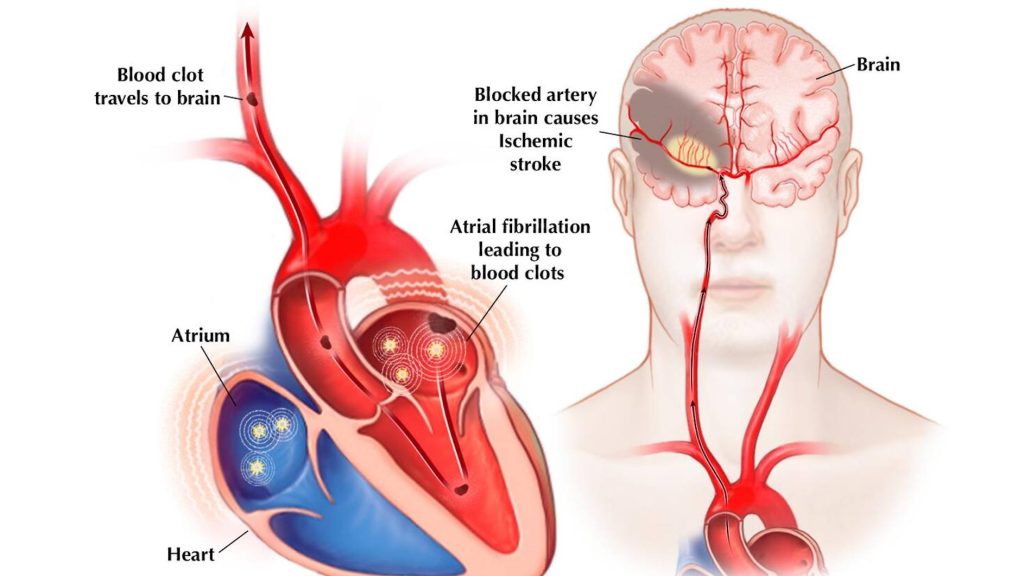-
Mayo Clinic Q & A: Why a fluttering heart could lead to stroke

DEAR MAYO CLINIC: I've been diagnosed with atrial fibrillation. I've read that it puts me at greater risk of stroke. Can you tell me more about this?
ANSWER: You may not have known you had atrial fibrillation (AFib) until your condition was discovered during a physical examination. For others, AFib can have life-altering symptoms that affect their ability to perform daily activities.
Atrial fibrillation is a common type of heart rhythm disorder where the heart doesn't beat efficiently. This makes the heart unable to pump enough blood out to the body with each heartbeat. It’s estimated 12.1 million people in the U.S. will be diagnosed with AFib by 2030.

Lowering stroke risk
People with AFib are at a higher risk of stroke — about 1 in 7 strokes are AFib related — due to clots that can form in the upper chambers of the heart. Of the strokes resulting from atrial fibrillation, 90% occur from clots originating in the left atrial appendage in the left atrium of the heart.
Key risk factors for stroke in people with atrial fibrillation include:
- Age
- Gender
- High blood pressure
- Prior history of stroke
- Chronic health conditions, including congestive heart failure, coronary artery disease and diabetes
Treating AFib
There are three main approaches to treating AFib. These are:
- Medical therapy for maintaining normal rhythm and preventing clots.
- Therapy to reset the heart rhythm, called cardioversion.
- Procedures to obtain and maintain normal heart rhythm.
Medications.
Medications for treating AFib are the front line for managing symptoms and preventing stroke. These medicines can:
- Prevent blood clots.
- Control the speed of the heartbeat.
- Restore the heart rhythm.
This group of medications includes beta blockers, calcium channel blockers, digoxin, arrhythmics and anticoagulants. Your cardiology team will work together to determine which medication will work best for you.
Cardioversion.
Cardioversion is usually done in a hospital as a scheduled procedure. Patients may still need to take medicines for the rest of their lives to control their heart rhythm and prevent future episodes of atrial fibrillation. Even with medicine, AFib could return.
Procedural options.
People who are candidates for procedural options are cared for by a team of cardiologists, including cardiac electrophysiologists and additional specialists as needed. Potential procedures include:
- Left atrial appendage occlusion. The left atrial occlusion is a pouch-like extension of the heart. A minimally invasive procedure provides an alternative to long-term blood-thinner medications. It involves implanting a device, via a catheter, to close and seal off the left atrial appendage. This decreases the risk of blood clots entering the bloodstream, traveling to the brain or other body organs, and causing a stroke or organ damage. Patients typically leave the hospital the same day or the next day.
- Ablation. Ablation stops the generation of abnormal electrical signals in the heart and keeps it in normal, or sinus, rhythm. During ablation, a catheter is fed into the heart through the groin area using a minimally invasive approach and delivers heat or cold to modify the tissues in the heart that are causing the arrhythmia.
- Pulsed field ablation (PFA). PFA stands out from traditional atrial fibrillation (AFib) treatments due to its precision and safety. Unlike radiofrequency or cryoablation, which use heat or cold to destroy heart tissue, PFA uses short electrical pulses to target the myocardium, minimizing damage to the esophagus and nerves.
Benefits to patients include:
- Reduced procedure and anesthesia time
- Quicker recovery time
- Surrounding tissue protection
- Hybrid ablation. For people who have long-standing, persistent atrial fibrillation, ablation alone is successful half of the time. Hybrid ablation is an option for people with atrial fibrillation that's hard to manage or who have been in atrial fibrillation for more than a year. It combines the best of the catheter lab ablation and an open surgical approach.
The procedure is done in two parts:
- Part one is performed by surgeons with a scope inserted through a small incision under the breastbone to ablate the back side of the heart, followed by closure of the left atrial appendage.
- During part two, a catheter ablation modifies the tissues on the inside of the heart.
This whole-heart approach allows patients to return to normal rhythm with excellent results.
Vaibhav Vaidya, M.B.B.S., Gurpreet Singh, M.B.B.S., and Nishant Saran, M.B.B.S., Cardiology, Mayo Clinic Health System, Eau Claire, Wisconsin.







